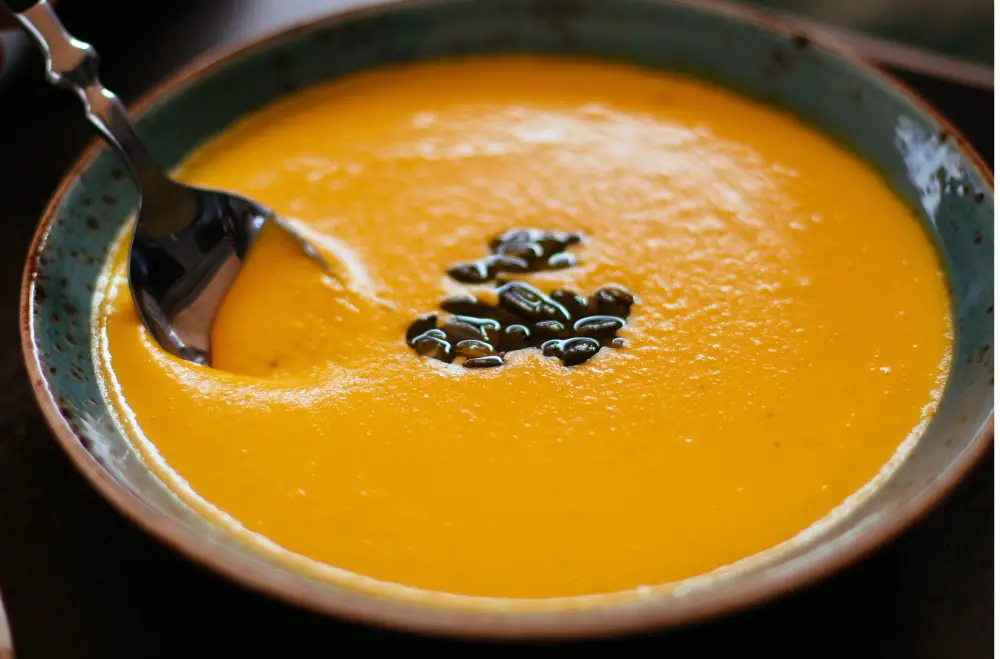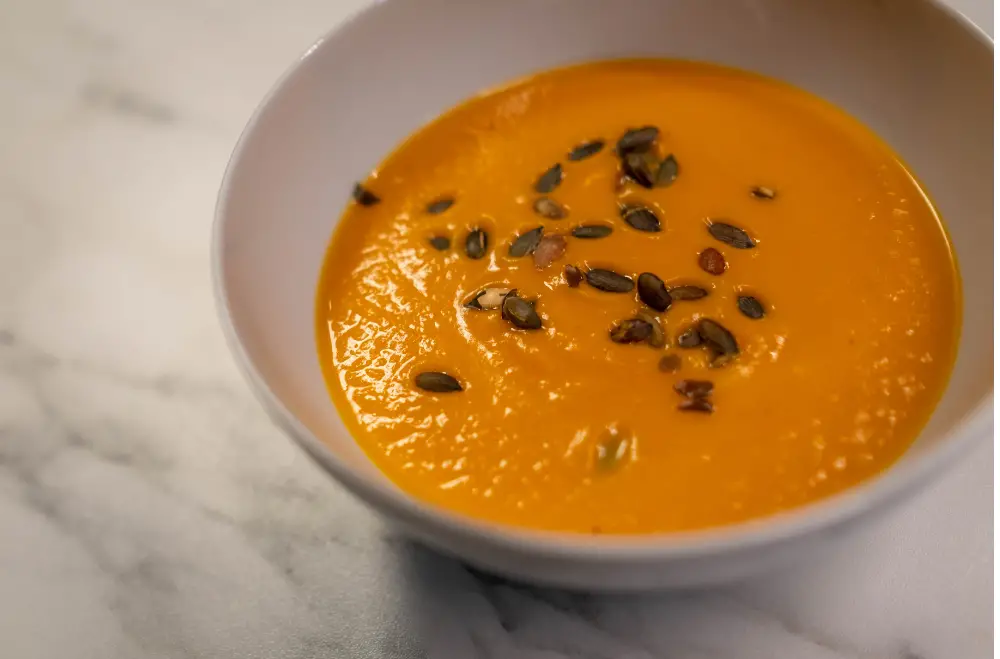Introduction to Pumpkin Soup
umpkin soup stands as a beloved culinary classic, revered for its comforting warmth and rich, creamy texture. With origins dating back centuries, this dish has earned its place as a staple in kitchens around the world. Its appeal lies not only in its delicious taste but also in its remarkable nutritional profile. Packed with vitamins, minerals, and antioxidants, pumpkin soup offers a nourishing boost to both body and soul.
What truly sets pumpkin soup apart is its incredible versatility. From the hearty simplicity of a traditional recipe to innovative variations inspired by global cuisines, there’s a pumpkin soup to suit every palate and occasion. Whether infused with aromatic spices for a Thai twist, enriched with creamy coconut milk for a tropical flair, or accented with savory herbs for a European touch, the possibilities are endless. Pumpkin soup transcends cultural boundaries, serving as a canvas for culinary creativity and a symbol of comfort and hospitality worldwide.
In this article, we’ll delve deep into the world of pumpkin soup, exploring its origins, health benefits, and myriad culinary interpretations. Join us as we embark on a journey to discover the magic of this timeless dish and unlock the secrets to crafting the perfect bowl of pumpkin soup.
Pumpkin soup isn’t just a delicious comfort food; it’s also packed with numerous health benefits that make it a wise addition to any diet. Here’s a closer look at why enjoying a bowl of pumpkin soup can be good for you:
- Rich in Nutrients: Pumpkins are loaded with essential vitamins and minerals, including vitamin A, vitamin C, potassium, and fiber. These nutrients are vital for supporting overall health and well-being.
- Boosts Immunity: The high vitamin A content in pumpkin soup can help strengthen the immune system, making it more resilient against infections and illnesses.
- Promotes Eye Health: Vitamin A is crucial for maintaining healthy vision, and pumpkin soup is an excellent source of this nutrient. Regular consumption may help protect against age-related vision problems such as macular degeneration.
- Supports Heart Health: The fiber, potassium, and antioxidants found in pumpkin soup contribute to heart health by helping to regulate blood pressure, lower cholesterol levels, and reduce the risk of heart disease.
- Aids in Weight Management: Pumpkin soup is low in calories and fat but high in fiber, making it a satisfying yet nutritious option for those watching their weight. The fiber content helps promote feelings of fullness, reducing the likelihood of overeating.
- Provides Antioxidant Protection: Pumpkins contain antioxidants such as beta-carotene, which help neutralize harmful free radicals in the body. These antioxidants play a crucial role in reducing inflammation and lowering the risk of chronic diseases.
- Gut Health: The fiber in pumpkin soup promotes a healthy digestive system by supporting regular bowel movements and nourishing beneficial gut bacteria.
- Hydration: Pumpkins have a high water content, which helps keep you hydrated and contributes to overall hydration levels, essential for various bodily functions.
Incorporating pumpkin soup into your regular diet can be a flavorful way to reap these health benefits while enjoying a comforting and satisfying meal.
Traditional Pumpkin Soup Recipe

Indulging in a traditional pumpkin soup is like savoring a taste of warmth and comfort in every spoonful. This timeless recipe celebrates the rich flavors of autumn and the earthy sweetness of fresh pumpkins. Here’s how to whip up a classic batch of pumpkin soup in your own kitchen:
Ingredients:
- 2 tablespoons olive oil or butter
- 1 onion, chopped
- 2 cloves garlic, minced
- 1 medium-sized pumpkin, peeled, seeded, and diced (about 4 cups)
- 4 cups vegetable or chicken broth
- 1 teaspoon ground cinnamon
- 1/2 teaspoon ground nutmeg
- Salt and pepper to taste
- 1/2 cup heavy cream (optional)
- Fresh parsley or chives for garnish (optional)
Instructions:
- Sauté Aromatics: In a large soup pot or Dutch oven, heat the olive oil or butter over medium heat. Add the chopped onion and minced garlic, and sauté until softened and fragrant, about 5 minutes.
- Add Pumpkin: Stir in the diced pumpkin and cook for another 5 minutes, allowing the pumpkin to slightly caramelize and develop flavor.
- Simmer: Pour in the vegetable or chicken broth, ensuring that the pumpkin is fully submerged. Bring the mixture to a gentle boil, then reduce the heat to low and let it simmer, covered, for 20-25 minutes, or until the pumpkin is tender and easily pierced with a fork.
- Season: Once the pumpkin is cooked through, season the soup with ground cinnamon, nutmeg, salt, and pepper. Adjust the seasoning to taste, adding more spices if desired for extra flavor.
- Blend: Using an immersion blender or transferring the soup to a countertop blender in batches, carefully blend the soup until smooth and creamy. Be cautious when blending hot liquids to avoid splattering.
- Finish: If using, stir in the heavy cream to add richness and creaminess to the soup. Allow the soup to heat through gently over low heat, but do not let it boil once the cream has been added.
- Serve: Ladle the hot pumpkin soup into bowls and garnish with fresh parsley or chives for a pop of color and freshness. Serve immediately, accompanied by crusty bread or your favorite soup accompaniment.
This traditional pumpkin soup recipe captures the essence of fall in every spoonful, offering a comforting and nourishing dish that’s perfect for cozy evenings at home or festive gatherings with loved ones. Enjoy the warmth and goodness of homemade pumpkin soup all season long.
Nutritional Value of Pumpkin Soup
Understanding the nutritional value of pumpkin soup is essential for making informed dietary choices and harnessing the health benefits it offers. Here’s a breakdown of the key nutrients found in a typical serving of pumpkin soup:
Calories: A standard serving of pumpkin soup, approximately one cup, contains around 100-150 calories, making it a relatively low-calorie option compared to other creamy soups.
Carbohydrates: Pumpkin soup is moderately rich in carbohydrates, primarily from the pumpkin itself. A serving typically provides 15-20 grams of carbohydrates, which include both simple sugars and dietary fiber.
Protein: While not a significant source of protein, pumpkin soup still contributes a small amount to your daily protein intake. A serving usually contains 2-4 grams of protein, depending on the recipe and any additional ingredients.
Fat: The fat content in pumpkin soup varies depending on whether cream or butter is used in the recipe. A serving may contain 5-10 grams of fat, with the majority being unsaturated fats from sources like olive oil or pumpkin seeds.
Vitamins and Minerals: Pumpkin soup is packed with essential vitamins and minerals, particularly vitamin A, vitamin C, potassium, and iron. These nutrients support various bodily functions, including immune health, vision, and heart function.
Fiber: Thanks to the presence of pumpkin and other vegetables, pumpkin soup is a good source of dietary fiber. A serving typically provides 3-5 grams of fiber, promoting digestive health and helping to keep you feeling full and satisfied.
Variations of Pumpkin Soup
Pumpkin soup holds a special place in holiday feasts and gatherings, offering a comforting and festive touch to the table. Whether it’s Thanksgiving, Halloween, Christmas, or any other occasion, serving pumpkin soup adds warmth and flavor to the celebration. Here are some ideas for incorporating pumpkin soup into your holiday menus:
- Thanksgiving Pumpkin Soup with Holiday Spices: Kick off your Thanksgiving feast with a bowl of pumpkin soup infused with traditional holiday spices like cinnamon, nutmeg, and cloves. This fragrant and flavorful soup sets the tone for a festive meal and whets the appetite for the delicious dishes to come.
- Halloween-Themed Pumpkin Soup with Festive Toppings: Get into the spirit of Halloween by serving pumpkin soup with fun and spooky toppings. Think jack-o’-lantern-shaped croutons, spiderweb swirls of sour cream, or edible “eyeballs” made from olives. This playful presentation adds a whimsical touch to your Halloween spread and delights guests of all ages.
- Christmas Pumpkin Soup with a Touch of Nutmeg and Cranberries: Add a touch of holiday cheer to your Christmas dinner with a bowl of creamy pumpkin soup garnished with a sprinkle of nutmeg and a drizzle of cranberry sauce. The combination of sweet and savory flavors captures the essence of the season and makes for a festive and elegant starter.
- New Year’s Eve Pumpkin Soup Shooters: For a stylish and sophisticated New Year’s Eve party, serve pumpkin soup in shot glasses as elegant appetizers or palate cleansers between courses. Garnish each shooter with a dollop of whipped cream and a sprinkle of cinnamon for a luxurious touch that’s sure to impress your guests.
- Easter Brunch Pumpkin Soup with Fresh Herbs: Add a touch of springtime freshness to your Easter brunch with a light and refreshing pumpkin soup garnished with fresh herbs like chives, parsley, or dill. This vibrant and flavorful soup pairs beautifully with other seasonal dishes and makes for a delightful addition to your holiday spread.
FAQs about Pumpkin Soup
- How can I make pumpkin soup thicker?
- To thicken pumpkin soup, you can simmer it for longer to reduce the liquid content, or add ingredients like potatoes or beans, which will naturally thicken the soup as they cook and break down.
- What can I substitute for pumpkin in pumpkin soup?
- If you don’t have pumpkin on hand, you can substitute other winter squashes such as butternut squash, acorn squash, or kabocha squash. These varieties offer similar flavors and textures, making them suitable alternatives in pumpkin soup recipes.
- Can I add meat to pumpkin soup?
- Yes, you can add meat to pumpkin soup to enhance its flavor and protein content. Cooked chicken, turkey, sausage, or bacon are popular options for adding a savory twist to pumpkin soup. Simply cook the meat separately and add it to the soup before serving.
- Are there any pumpkin soup recipes suitable for baby-led weaning?
- Yes, you can adapt pumpkin soup recipes for baby-led weaning by omitting any added salt or spices and ensuring that the soup is pureed to a smooth consistency. You can also introduce small amounts of plain yogurt or cream for added creaminess and nutrients.
Conclusion
In conclusion, pumpkin soup is more than just a delicious dish—it’s a symbol of warmth, comfort, and culinary creativity. Whether enjoyed as a cozy meal on a chilly evening or served as an elegant starter at a festive gathering, pumpkin soup has a timeless appeal that transcends seasons and cultures.
From its rich nutritional profile to its endless variations and adaptability, pumpkin soup offers something for everyone to enjoy. Whether you prefer a classic recipe, a spicy twist, or a creamy vegan version, there’s no shortage of ways to savor the flavors of this beloved autumn staple.
So next time you’re craving a bowl of comfort, consider whipping up a batch of pumpkin soup and let its velvety texture and aromatic spices warm your soul. With its versatility and undeniable charm, pumpkin soup is sure to become a cherished favorite in your culinary repertoire.

